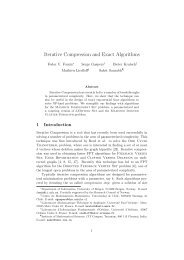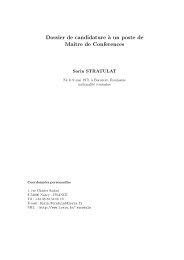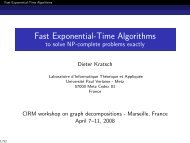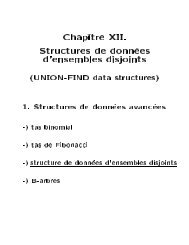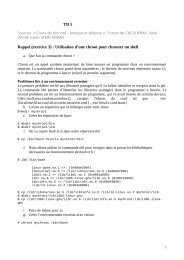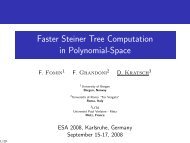Fast Steiner tree computation in polynomial space - Lita
Fast Steiner tree computation in polynomial space - Lita
Fast Steiner tree computation in polynomial space - Lita
You also want an ePaper? Increase the reach of your titles
YUMPU automatically turns print PDFs into web optimized ePapers that Google loves.
<strong>Fast</strong>er <strong>Ste<strong>in</strong>er</strong> Tree Computation <strong>in</strong><br />
Polynomial-Space<br />
Fedor V. Fom<strong>in</strong> 1⋆ , Fabrizio Grandoni 2⋆⋆ , and Dieter Kratsch 3<br />
1 Department of Informatics, University of Bergen, N-5020 Bergen, Norway,<br />
fom<strong>in</strong>@ii.uib.no<br />
2 Dipartimento di Informatica, Sistemi e Produzione, Università diRoma“Tor<br />
Vergata”, via del Politecnico 1, 00133, Roma, Italy, grandoni@disp.uniroma2.it<br />
3 LITA, Université Paul Verla<strong>in</strong>e-Metz, 57045 Metz Cedex 01, France,<br />
kratsch@univ-metz.fr<br />
Abstract. Given an n-node graph and a subset of k term<strong>in</strong>al nodes,<br />
the NP-hard <strong>Ste<strong>in</strong>er</strong> <strong>tree</strong> problem is to compute a m<strong>in</strong>imum-size <strong>tree</strong><br />
which spans the term<strong>in</strong>als. All the known algorithms for this problem<br />
which improve on trivial O(1.62 n )-timeenumerationarebasedondynamic<br />
programm<strong>in</strong>g, and require exponential <strong>space</strong>.<br />
Motivated by the fact that exponential-<strong>space</strong> algorithms are typically<br />
impractical, <strong>in</strong> this paper we address the problem of design<strong>in</strong>g faster<br />
<strong>polynomial</strong>-<strong>space</strong> algorithms. Our first contribution is a simple <strong>polynomial</strong><strong>space</strong><br />
O(6 k n O(log k) )-time algorithm, based on a variant of the classical<br />
<strong>tree</strong>-separator theorem. This improves on trivial O(n k+O(1) )enumeration<br />
for, roughly, k ≤ n/4.<br />
Comb<strong>in</strong><strong>in</strong>g the algorithm above (for small k), with an improved branch<strong>in</strong>g<br />
strategy (for large k), we obta<strong>in</strong> an O(1.60 n )-time <strong>polynomial</strong>-<strong>space</strong><br />
algorithm. The ref<strong>in</strong>ed branch<strong>in</strong>g is based on a charg<strong>in</strong>g mechanism<br />
which shows that, for large values of k, convenient local configurations<br />
of term<strong>in</strong>als and non-term<strong>in</strong>als must exist. The analysis of the algorithm<br />
relies on the Measure & Conquer approach: the non-standard measure<br />
used here is a l<strong>in</strong>ear comb<strong>in</strong>ation of the number of nodes and number of<br />
non-term<strong>in</strong>als.<br />
As a byproduct of our work, we also improve the (exponential-<strong>space</strong>)<br />
time complexity of the problem from O(1.42 n )toO(1.36 n ).<br />
1 Introduction<br />
The <strong>Ste<strong>in</strong>er</strong> <strong>tree</strong> problem is one of the best-known optimization problems: Given<br />
a connected graph G =(V,E) onn = |V | nodes, edge costs c : E → R + and<br />
asetT ⊆ V of k = |T | term<strong>in</strong>als, the objective is to f<strong>in</strong>d a sub<strong>tree</strong> S of G<br />
spann<strong>in</strong>g T such that the cost of S (i.e. the total cost of its edges) is m<strong>in</strong>imum.<br />
<strong>Ste<strong>in</strong>er</strong> <strong>tree</strong>s are important <strong>in</strong> various applications such as VLSI rout<strong>in</strong>gs [22],<br />
phylogenetic <strong>tree</strong> reconstruction [21] and network rout<strong>in</strong>g [24]. We refer to the<br />
⋆ Supported by the Norwegian Research Council<br />
⋆⋆ Partially supported by MIUR under project MAINSTREAM.
ook of Prömel and Steger [27] for an overview of the results and applications<br />
of the <strong>Ste<strong>in</strong>er</strong> <strong>tree</strong> problem.<br />
The <strong>Ste<strong>in</strong>er</strong> <strong>tree</strong> problem is known to be NP-hard [18]. Furthermore, it is<br />
APX-complete, even when the graph is complete and all edge costs are either 1<br />
or 2 [3]. F<strong>in</strong>d<strong>in</strong>g the best approximation algorithm for the <strong>Ste<strong>in</strong>er</strong> <strong>tree</strong> problem<br />
has been a challenge and many papers have been written on this subject. The currently<br />
best <strong>polynomial</strong>-time approximation algorithm for the <strong>Ste<strong>in</strong>er</strong> <strong>tree</strong> problem,<br />
due to Rob<strong>in</strong>s and Zelikovsky, has approximation ratio 1 + (ln 3)/2 < 1.55<br />
[28]. Among other results, Rob<strong>in</strong>s and Zelikovsky establish an approximation<br />
ratio of 1.28 for complete graphs with edge costs 1 or 2. The <strong>Ste<strong>in</strong>er</strong> <strong>tree</strong> problem<br />
rema<strong>in</strong>s NP-hard for Euclidean and rectil<strong>in</strong>ear metrics [17]. On the positive<br />
side, Arora established <strong>polynomial</strong>-time approximation schemes for those two<br />
important variants of the <strong>Ste<strong>in</strong>er</strong> <strong>tree</strong> problem [1].<br />
The <strong>Ste<strong>in</strong>er</strong> <strong>tree</strong> problem plays a crucial role also <strong>in</strong> parameterized algorithms<br />
[9,12,26]. The aim here is design<strong>in</strong>g the fastest possible algorithm under the (realistic)<br />
assumption that k ≪ n. For more than 30 years the fastest parameterized<br />
algorithm for the <strong>Ste<strong>in</strong>er</strong> Tree problem was the classical O ∗ (3 k ) dynamic programm<strong>in</strong>g<br />
algorithm by Dreyfus and Wagner [10]. 4 Dreyfus-Wagner’s algorithm<br />
is still probably the most popular algorithm used for solv<strong>in</strong>g different variants<br />
of the <strong>Ste<strong>in</strong>er</strong> <strong>tree</strong> problem <strong>in</strong> practice [8,16]. This algorithm and its variations<br />
are also used as a subrout<strong>in</strong>e <strong>in</strong> many other algorithms. For example, recent applications<br />
of it can be found <strong>in</strong> fixed parameter tractable algorithms for certa<strong>in</strong><br />
vertex cover problems [19] and for near-perfect phylogenetic <strong>tree</strong> reconstruction<br />
[6]. Recent progress <strong>in</strong> parameterized complexity and exact algorithms led to<br />
new <strong>in</strong>sights on the <strong>Ste<strong>in</strong>er</strong> <strong>tree</strong> problem. Mölle, Richter, and Rossmanith [25]<br />
(see also [15]) improved the runn<strong>in</strong>g time to O ∗ ((2+ɛ) k ), for any constant ɛ>0.<br />
More recently, Björklund, Husfeldt, Kaski, and Koivisto [5] obta<strong>in</strong>ed an O ∗ (2 k )<br />
time algorithm for the version of the problem where edges have bounded <strong>in</strong>teger<br />
weights. All the mentioned algorithms are based on a dynamic programm<strong>in</strong>g approach:<br />
they store useful auxiliary <strong>in</strong>formation for every subset of the term<strong>in</strong>al<br />
set, and thus use exponential <strong>space</strong> Ω(2 k ).<br />
For arbitrary values of k, the fastest known O ∗ (1.4143 n )-time (exponential<strong>space</strong>)<br />
algorithm for the <strong>Ste<strong>in</strong>er</strong> <strong>tree</strong> problem is obta<strong>in</strong>ed by comb<strong>in</strong><strong>in</strong>g the algorithm<br />
by Mölle et al. [25] (for small k) with trivial enumeration (for large<br />
k).<br />
Exponential-<strong>space</strong> versus <strong>polynomial</strong>-<strong>space</strong>. The situation with exact algorithms<br />
for the <strong>Ste<strong>in</strong>er</strong> <strong>tree</strong> problem is quite typical for a number of other<br />
NP-hard problems: the best exponential time complexity is achieved by algorithms<br />
with exponential <strong>space</strong> complexity [29]. However, algorithms with very<br />
high <strong>space</strong> complexity are unlikely to be fast <strong>in</strong> practice, especially when external<br />
memory accesses are frequent. This k<strong>in</strong>d of phenomena is not captured by<br />
the standard RAM model. Hence it makes sense to search for algorithms with<br />
4 Throughout this paper we use the O ∗ notation which suppresses <strong>polynomial</strong> factors:<br />
for any <strong>polynomial</strong> p(n), O(p(n)f(n)) is O ∗ (f(n)).
low memory requirements, even if they are asymptotically slower than their<br />
exponential-<strong>space</strong> counterpart. Polynomial-<strong>space</strong> exact algorithms have been<br />
studied for various NP-hard problems, among them Hamiltonian Path [2,20,23]<br />
and Color<strong>in</strong>g [4].<br />
For k = ω(log n), the exist<strong>in</strong>g parameterized algorithms for the <strong>Ste<strong>in</strong>er</strong> <strong>tree</strong><br />
problem are not <strong>polynomial</strong>-<strong>space</strong>. Under that assumption, the fastest known<br />
<strong>polynomial</strong>-<strong>space</strong> algorithm is the (almost) trivial enumerative algorithm, based<br />
on the follow<strong>in</strong>g observation. S<strong>in</strong>ce all the leaves of any optimal <strong>Ste<strong>in</strong>er</strong> <strong>tree</strong> are<br />
term<strong>in</strong>als, the number of <strong>Ste<strong>in</strong>er</strong> nodes T ′ of degree 3 or larger is at most k.<br />
Given T ′ , the <strong>Ste<strong>in</strong>er</strong> <strong>tree</strong> problem is equivalent to the m<strong>in</strong>imum spann<strong>in</strong>g <strong>tree</strong><br />
problem on GM [T ∪ T ′ ], where GM isthemetricclosureofG. Such problem<br />
can be solved <strong>in</strong> <strong>polynomial</strong> time. Hence it is sufficient to list all the subsets<br />
T ′ ⊆ N := V \ T of size at most k, and then apply the observation above. This<br />
takes time O( �k � � n−k O(1) ∗ k<br />
i=1 i n ). For k ≪ n this runn<strong>in</strong>g time is O (n ), while<br />
for arbitrary values of k it is O∗ (1.6181n ).<br />
Our Results and Techniques. Motivated by the practical limitations of<br />
exponential-<strong>space</strong> algorithms and by the theoretical <strong>in</strong>terest of the topic itself,<br />
<strong>in</strong> this paper we address the problem of design<strong>in</strong>g faster <strong>polynomial</strong>-<strong>space</strong> exact<br />
algorithms for the <strong>Ste<strong>in</strong>er</strong> <strong>tree</strong> problem. In particular, we present an exact algorithm<br />
for the card<strong>in</strong>ality version of the problem (where every edge is of weight<br />
one), of runn<strong>in</strong>g time O∗ (1.5949n ). This result is achieved <strong>in</strong> three steps:<br />
• We describe a new, easy-to-implement, <strong>Ste<strong>in</strong>er</strong> <strong>tree</strong> algorithm, tak<strong>in</strong>g<br />
O(5.96knO(log k) ) time and <strong>polynomial</strong> <strong>space</strong>. This means an improvement on<br />
known <strong>polynomial</strong>-<strong>space</strong> results for ω(log n) =k ≤ 0.269 n, whichcoversmany<br />
real-world <strong>in</strong>stances. Our result is based on a simple variant of the classical <strong>tree</strong>separator<br />
theorem: shortly, there is a node <strong>in</strong> every <strong>Ste<strong>in</strong>er</strong> <strong>tree</strong> which separates<br />
two balanced subsets of term<strong>in</strong>als. This can be exploited <strong>in</strong> a top-down recursive<br />
implementation of the classical algorithm by Dreyfus and Wagner, hence achiev<strong>in</strong>g<br />
runn<strong>in</strong>g time O((27/4) knO(log k) ) and <strong>polynomial</strong>-<strong>space</strong>. The runn<strong>in</strong>g time<br />
canberef<strong>in</strong>edtoO(5.96knO(log k) ) by exploit<strong>in</strong>g the properties of the <strong>Ste<strong>in</strong>er</strong><br />
separators <strong>in</strong> comb<strong>in</strong>ation with a more careful branch<strong>in</strong>g. This algorithm works<br />
also <strong>in</strong> the weighted case, and might be of <strong>in</strong>dependent, practical <strong>in</strong>terest5 .<br />
• We design an improved branch<strong>in</strong>g strategy, based on the follow<strong>in</strong>g idea. When<br />
k is small, it is convenient to use the algorithm above. Otherwise, there must be<br />
clusters of term<strong>in</strong>als “close” to each other. This property can be used to guide<br />
the branch<strong>in</strong>g process. From the technical po<strong>in</strong>t of view, we use a simple charg<strong>in</strong>g<br />
mechanism to show that, for large k’s, the graph must conta<strong>in</strong> one of a small list<br />
of local configurations of term<strong>in</strong>als and non-term<strong>in</strong>als. On such configurations<br />
we are able to branch better than trivially.<br />
• We analyze the algorithm above with the Measure & Conquer technique described<br />
<strong>in</strong> [13,14], and based on the quasiconvex analysis of multivariate recurrences<br />
by Eppste<strong>in</strong> [11]. The basic idea is design<strong>in</strong>g a convenient (non-trivial)<br />
5 An experimental analysis of our algorithms is postponed to future work.
measure of the size of the problem. This measure is used to bound <strong>in</strong> a tighter<br />
way the progress made by the recursive algorithm considered at each branch<strong>in</strong>g<br />
step. The runn<strong>in</strong>g time obta<strong>in</strong>ed with respect to the ref<strong>in</strong>ed measure is eventually<br />
turned <strong>in</strong>to the equivalent runn<strong>in</strong>g time <strong>in</strong> terms of the standard measure<br />
considered (typically the number of nodes or edges for graph problems). As it<br />
will be clearer from the analysis, a convenient measure <strong>in</strong> our case is a l<strong>in</strong>ear<br />
comb<strong>in</strong>ation of the number n of nodes and number nN = n − k of non-term<strong>in</strong>als<br />
<strong>in</strong> the graph.<br />
Prelim<strong>in</strong>aries. In the follow<strong>in</strong>g stG(T ) denotes the m<strong>in</strong>imum number of edges<br />
of a <strong>Ste<strong>in</strong>er</strong> <strong>tree</strong> of graph G over term<strong>in</strong>al set T . When the graph G is clear from<br />
the context, we will simply write st(T ). By contract<strong>in</strong>g a subset of nodes V ′ ,we<br />
mean (i) remov<strong>in</strong>g V ′ from the graph, (ii) add<strong>in</strong>g a new node v ′ , and (iii) add<strong>in</strong>g<br />
one edge between v ′ and each neighbor of V ′ not <strong>in</strong> V ′ . The follow<strong>in</strong>g lemma is<br />
easy to verify.<br />
Lemma 1. (Contraction Lemma) Let (G, T ) be an <strong>in</strong>stance of the card<strong>in</strong>ality<br />
<strong>Ste<strong>in</strong>er</strong> <strong>tree</strong> problem. Also let V ′ be a connected component of term<strong>in</strong>als, G ′ be the<br />
graph result<strong>in</strong>g from contract<strong>in</strong>g V ′ <strong>in</strong> a unique node v ′ ,andT ′ = T ∪{v ′ }\V ′ .<br />
Then<br />
stG(T )=|V ′ |−1+stG ′(T ′ ).<br />
The rest of this paper is organized as follows. In Section 2 we present our<br />
O(5.96 k n O(log k) ) <strong>polynomial</strong>-<strong>space</strong> algorithm. The ref<strong>in</strong>ed branch<strong>in</strong>g strategy<br />
based on the charg<strong>in</strong>g argument is described <strong>in</strong> Section 3, and analyzed <strong>in</strong> Section<br />
4 with the Measure & Conquer technique.<br />
2 <strong>Ste<strong>in</strong>er</strong> Tree via <strong>Ste<strong>in</strong>er</strong> Separators<br />
In this section we describe a simple <strong>polynomial</strong>-<strong>space</strong> algorithm for the <strong>Ste<strong>in</strong>er</strong><br />
<strong>tree</strong> problem of runn<strong>in</strong>g time O((27/4) k n O(log k) ). We later show how to reduce<br />
thetimecomplexitytoO(5.96 k n O(log k) ). We remark that, with m<strong>in</strong>or modifications,<br />
this algorithm works also <strong>in</strong> the weighted case.<br />
Our algorithm is <strong>in</strong>spired by the classical dynamic programm<strong>in</strong>g algorithm<br />
D&W by Dreyfus and Wagner [10], which takes O ∗ (3 k ) time and exponential <strong>space</strong>.<br />
Algorithm D&W is based on the follow<strong>in</strong>g observation. Consider any <strong>Ste<strong>in</strong>er</strong> <strong>tree</strong><br />
S on the set of term<strong>in</strong>als T , |T |≥3. There must be an <strong>in</strong>ternal node s ∈ S, not<br />
necessarily a term<strong>in</strong>al, such that the sub<strong>tree</strong>s of S rooted at s can be partitioned<br />
<strong>in</strong> two forests R1 and R2, each one conta<strong>in</strong><strong>in</strong>g at least one term<strong>in</strong>al. Let Ti be<br />
the term<strong>in</strong>als <strong>in</strong> Ri, i ∈{1, 2}. If we compute optimal <strong>Ste<strong>in</strong>er</strong> <strong>tree</strong>s on term<strong>in</strong>als<br />
T1 ∪{s} and T2 ∪{s}, and we merge them, we obta<strong>in</strong> an optimal <strong>Ste<strong>in</strong>er</strong> <strong>tree</strong> for<br />
the orig<strong>in</strong>al problem. Of course we do not know s nor (T1,T2) a priori, but we can<br />
guess them by enumerat<strong>in</strong>g all the possible cases. Recall that stG(T )=st(T )is<br />
the m<strong>in</strong>imum cost of a <strong>Ste<strong>in</strong>er</strong> <strong>tree</strong> of G on term<strong>in</strong>als T . The follow<strong>in</strong>g equation<br />
holds:<br />
st(T )=m<strong>in</strong> m<strong>in</strong><br />
s∈V (T1,T2)∈P(s,T ) {st(T1 ∪{s})+st(T2 ∪{s})}, (1)
Figure 1 Tight example for Lemma 2 (black nodes are term<strong>in</strong>als): a <strong>Ste<strong>in</strong>er</strong><br />
separator s, and the correspond<strong>in</strong>g forests R1 and R2 with |T1| = k/3 and<br />
|T2| =2k/3 term<strong>in</strong>als, respectively. Note that <strong>in</strong> R2 ∪{s}, nodes separates two<br />
perfectly balanced forests R2a and R2b.<br />
R2<br />
R2a<br />
R2b<br />
s<br />
where P(s, T ) is the set of possible partitions (T1,T2) ofT \{s} <strong>in</strong> two nonempty<br />
subsets. Algorithm D&W simply applies Equation (1) to any subset of T ,<br />
<strong>in</strong> a bottom-up fashion, stor<strong>in</strong>g each partial solution computed for later <strong>computation</strong>s.<br />
Stor<strong>in</strong>g the partial solutions takes Ω(2 k ) <strong>space</strong>.<br />
A simple-m<strong>in</strong>ded approach to obta<strong>in</strong> a <strong>polynomial</strong>-<strong>space</strong> variant of D&W is<br />
to apply Equation (1) recursively, <strong>in</strong> a top-down fashion, without stor<strong>in</strong>g any<br />
partial solution. When |T |≤2, the problem is solved trivially <strong>in</strong> <strong>polynomial</strong><br />
time and <strong>space</strong> (base case). Unfortunately, this approach leads to a very high<br />
runn<strong>in</strong>g time. The ma<strong>in</strong> reason is that, by apply<strong>in</strong>g Equation (1) as it is, one<br />
generates some subproblems with almost the same number of term<strong>in</strong>als as <strong>in</strong> the<br />
orig<strong>in</strong>al problem.<br />
This problem can be circumvented by exploit<strong>in</strong>g a variant of the classical<br />
<strong>tree</strong>-separator theorem. It is well known that any n-node<strong>tree</strong>conta<strong>in</strong>sanodes<br />
(separator) whose removal divides the <strong>tree</strong> <strong>in</strong> two forests, each one conta<strong>in</strong><strong>in</strong>g at<br />
most 2n/3 nodes. The same basic result holds if we put weights on the nodes [7].<br />
In particular, the follow<strong>in</strong>g lemma holds (see Figure 1 for a tight example).<br />
Lemma 2. [7] Consider any <strong>Ste<strong>in</strong>er</strong> <strong>tree</strong> S on the set of term<strong>in</strong>als T , |T | = k ≥<br />
3. Then there exists an <strong>in</strong>ternal node s ∈ S (<strong>Ste<strong>in</strong>er</strong>-separator), not necessarily<br />
a term<strong>in</strong>al, whose removal divides the <strong>tree</strong> <strong>in</strong> two forests, each one conta<strong>in</strong><strong>in</strong>g at<br />
most 2k/3 term<strong>in</strong>als.<br />
As a consequence of Lemma 2, when apply<strong>in</strong>g Equation (1), we do not really<br />
need to consider all the partitions <strong>in</strong> P(s, T ), but it is sufficient to consider only<br />
the subset B(s, T ) ⊆P(s, T ) of (“almost balanced”) partitions (T1,T2) where<br />
|T1| ≤|T2| ≤2k/3:<br />
st(T )=m<strong>in</strong><br />
s∈V<br />
m<strong>in</strong><br />
(T1,T2)∈B(s,T ) {st(T1 ∪{s})+st(T2 ∪{s})}. (2)<br />
Us<strong>in</strong>g Equation (2) <strong>in</strong>stead of (1) makes no substantial difference with the dynamic<br />
programm<strong>in</strong>g approach by Dreyfus and Wagner: <strong>in</strong> fact, the most frequent<br />
R1
partitions (which determ<strong>in</strong>e the runn<strong>in</strong>g time) conta<strong>in</strong> a balanced number of term<strong>in</strong>als,<br />
and such partitions are conta<strong>in</strong>ed both <strong>in</strong> B(s, T )and<strong>in</strong>P(s, T ). The<br />
situation changes drastically <strong>in</strong> the top-down recursive implementation of the algorithm:<br />
here the runn<strong>in</strong>g time is essentially determ<strong>in</strong>ed by the most unbalanced<br />
partitions. Hence, replac<strong>in</strong>g P(s, T )withB(s, T ) has a tremendous impact on<br />
the performance of the algorithm.<br />
The follow<strong>in</strong>g <strong>Ste<strong>in</strong>er</strong> <strong>tree</strong> algorithm summarizes the discussion above:<br />
• (base case) If T = {v}, returnv. IfT = {v, w}, return the shortest path<br />
from v to w.<br />
• (recursive case) For every s ∈ V and for every partition (T1,T2) ofT \{s},<br />
|T1| ≤|T2| ≤2k/3, compute recursively optimal <strong>Ste<strong>in</strong>er</strong> <strong>tree</strong>s S1 and S2 over<br />
T1 ∪{s} and T2 ∪{s}, respectively. Return the cheapest <strong>Ste<strong>in</strong>er</strong> <strong>tree</strong> S1 ∪ S2<br />
obta<strong>in</strong>ed.<br />
Theorem 1. The <strong>Ste<strong>in</strong>er</strong> <strong>tree</strong> algorithm above takes time O((27/4) k n O(log k) )<br />
and <strong>polynomial</strong> <strong>space</strong>.<br />
Proof. The correctness of the algorithm follows from the discussion above, and<br />
its <strong>space</strong> complexity is trivially <strong>polynomial</strong>. Let P (k) be the number of base<br />
<strong>in</strong>stances generated by the algorithm to solve the problem. The time complexity<br />
of the algorithm is O(P (k)n O(1) log k) =O(P (k)n O(1) ), where we used the fact<br />
that each branch<strong>in</strong>g step takes <strong>polynomial</strong> time and the depth of the recursion<br />
is O(log k).<br />
It rema<strong>in</strong>s to bound P (k). We will show by <strong>in</strong>duction that P (k) ≤ Cn c ln k α k ,<br />
for some constants C>0, c>0, and α ≥ 4. Clearly the condition is true for<br />
k ≤ 2. Now assume it is satisfied for every h ≤ k − 1, and consider an <strong>in</strong>stance<br />
with k term<strong>in</strong>als. For a given partition (T1,T2), the number of base <strong>in</strong>stances<br />
generated is P (|T1| +1)+P (|T2| + 1). By construction, k/2 ≤|T2| ≤2k/3 and<br />
|T1| + |T2| ≤k. Hence, for sufficiently large constants C and c and for α =8,the<br />
follow<strong>in</strong>g <strong>in</strong>equalities hold:<br />
P (k) ≤ n<br />
2k/3 �<br />
i=k/2<br />
≤ 2nP(2k/3+1)<br />
� �<br />
k<br />
(P (i +1)+P (k − i +1))≤2n i<br />
2k/3 �<br />
i=k/2<br />
� �<br />
k<br />
i<br />
≤ Cn c ln k (2α 2/3 ) k ≤ Cn c ln k α k .<br />
2k/3 �<br />
i=k/2<br />
� �<br />
k<br />
P (i +1)<br />
i<br />
≤ 2nCn c ln(2k/3+1) α 2k/3+1 2 k<br />
Aboveweusedthefactthat2α 2/3 = α for α = 8. In order to obta<strong>in</strong> a better<br />
value of α, we use the follow<strong>in</strong>g observation.<br />
Fact 1 For every fixed x ≥ 4, function f(y) =<br />
<strong>in</strong>terval (0, 2/3].<br />
x y<br />
y y (1−y) 1−y is <strong>in</strong>creas<strong>in</strong>g on
From Stirl<strong>in</strong>g’s formula and Fact 1, for i ∈ [k/3, 2k/3],<br />
� �<br />
k<br />
Cn<br />
P (i +1)≤<br />
i<br />
c ln(i+1) αi+1 ((i/k) i/k (1 − i/k) 1−i/k ) k ≤ (αi/k ) k c ln(2k/3+1)<br />
αCn<br />
((i/k) i/k (1 − i/k) 1−i/k ) k<br />
�<br />
c ln(2k/3+1) α<br />
≤ αCn 2/3<br />
(2/3) 2/3 (1/3) 1/3<br />
�k<br />
� 2/3<br />
c ln(2k/3+1) 3α<br />
= αCn<br />
22/3 �k<br />
.<br />
It follows that<br />
P (k) ≤ 2n<br />
2k/3<br />
�<br />
i=k/2<br />
� �<br />
k<br />
c ln(2k/3+1)<br />
P (i +1)≤ 2nkαCn<br />
i<br />
� 3α 2/3<br />
2 2/3<br />
�k<br />
≤ Cn c ln k α k ,<br />
for sufficiently large constants C and c and for α =27/4. The claim follows.<br />
2.1 A Ref<strong>in</strong>ed Algorithm<br />
The algorithm of the previous section can be ref<strong>in</strong>ed thanks to the follow<strong>in</strong>g<br />
observation. Let S be an optimal <strong>Ste<strong>in</strong>er</strong> <strong>tree</strong>. Consider the <strong>Ste<strong>in</strong>er</strong>-separator<br />
s ∈ S lead<strong>in</strong>g to the most balanced partition (T1,T2)oftheterm<strong>in</strong>als,|T1| ≤|T2|.<br />
In case of a tie, we choose s such that the forest R2 associated to T2 conta<strong>in</strong>s<br />
the smallest possible number of nodes. In the worst possible case, |T1| = k/3<br />
and |T2| =2k/3. Note that <strong>in</strong> such case the forest R2 cannot be formed by a<br />
unique sub<strong>tree</strong> of S. This is because otherwise the root s ′ of such a sub<strong>tree</strong> would<br />
contradict the m<strong>in</strong>imality of s. It follows that we can further partition R2 <strong>in</strong> two<br />
sub-forests R2a and R2b. LetT2x be the term<strong>in</strong>als of R2x, x ∈{a, b}. Without<br />
loss of generality, we assume that |T2a| ≤|T2b|. Aga<strong>in</strong> by the m<strong>in</strong>imality of s, we<br />
have |T2b| ≤|T1| = k/3. In fact, otherwise the partition (T2b,T2a ∪ T1) wouldbe<br />
more balanced than (T1,T2) =(T1,T2a ∪ T2b). It follows that |T2a| = |T2b|, that<br />
is <strong>in</strong> the subproblem <strong>in</strong>duced by T2 there is a perfectly balanced partition (see<br />
Figure 1 for an example).<br />
This argument can be generalized <strong>in</strong> the follow<strong>in</strong>g way. Let γ ∈ (0, 1/6) be a<br />
given parameter. With the same notation as above, suppose |T2| ≥(2/3 − γ)k.<br />
Then it must be |T2a| ≤|T2b| ≤|T1| ≤(1/3 +γ)k. As a consequence, |T2b|<br />
|T2| ≤<br />
1/3+γ<br />
2/3−γ<br />
. For γ
<strong>in</strong> the current step. For subproblems of type (ii), the smaller is γ, the better<br />
is the recurrence obta<strong>in</strong>ed <strong>in</strong> the follow<strong>in</strong>g step. Optimiz<strong>in</strong>g γ ∈ (0, 1/15) we<br />
obta<strong>in</strong> the follow<strong>in</strong>g result, whose proof is omitted for lack of <strong>space</strong>.<br />
Theorem 2. For a proper choice of the parameter γ, the algorithm above solves<br />
the <strong>Ste<strong>in</strong>er</strong> <strong>tree</strong> problem <strong>in</strong> time O(5.96knO(log k) ) and <strong>polynomial</strong> <strong>space</strong>.<br />
In the follow<strong>in</strong>g we will denote by smallST the algorithm of Theorem 2. We<br />
remark that smallST is not fixed-parameter-tractable because of the factor<br />
nO(log k) <strong>in</strong> its runn<strong>in</strong>g time. F<strong>in</strong>d<strong>in</strong>g a <strong>polynomial</strong>-<strong>space</strong> fixed-parameter-tractable<br />
algorithm for <strong>Ste<strong>in</strong>er</strong> <strong>tree</strong> is left as a challeng<strong>in</strong>g open problem.<br />
3 Branch<strong>in</strong>g on Small-Load Term<strong>in</strong>als<br />
In this section we describe a simple, recursive algorithm ste<strong>in</strong>er for the <strong>Ste<strong>in</strong>er</strong><br />
<strong>tree</strong> problem, tak<strong>in</strong>g O(1.5949n ) time and <strong>polynomial</strong> <strong>space</strong>. Our algorithm computes<br />
the size stG(T ) of an optimal <strong>Ste<strong>in</strong>er</strong> <strong>tree</strong>, but it can be easily modified <strong>in</strong><br />
order to produce one optimal <strong>Ste<strong>in</strong>er</strong> <strong>tree</strong>.<br />
The ma<strong>in</strong> idea beh<strong>in</strong>d our approach is as follows. If k ≤ cn for a suitable<br />
constant c < 1, it is convenient to use the O(5.96knO(log k) ) algorithm from<br />
Section 2. Otherwise, there must be a term<strong>in</strong>al t which is at distance at most<br />
one from “many” other term<strong>in</strong>als. Thus, if by branch<strong>in</strong>g we add to T one or more<br />
non-term<strong>in</strong>als adjacent to t, we can contract a “large” connected component of<br />
term<strong>in</strong>als afterwards (us<strong>in</strong>g the Contraction Lemma 1). This phenomenon is not<br />
exploited <strong>in</strong> trivial enumeration, and it is at the base of our ref<strong>in</strong>ed branch<strong>in</strong>g<br />
algorithm.<br />
In order to formalize <strong>in</strong> a convenient way the mentioned phenomenon, we<br />
<strong>in</strong>troduce the follow<strong>in</strong>g def<strong>in</strong>ition of load of a term<strong>in</strong>al. Let each non-term<strong>in</strong>al<br />
node s ∈ N := V \ T be <strong>in</strong>itially assigned a load one. Node s evenly distributes<br />
its load among the term<strong>in</strong>als adjacent to it (if any). The f<strong>in</strong>al load w(t) ofeach<br />
term<strong>in</strong>al t is the sum of the loads received by its non-term<strong>in</strong>al neighbors. As it<br />
will be clearer from the analysis, we can branch efficiently on term<strong>in</strong>als of small<br />
load.<br />
We are now ready to describe algorithm ste<strong>in</strong>er:<br />
1. (base) If|T |∈{0, 1}, stG(T )=0:<br />
ste<strong>in</strong>er(G, T )=0.<br />
2. (contraction) If there is a connected component V ′ of at least 2 term<strong>in</strong>als,<br />
we apply Lemma 1. Let G ′ be the graph obta<strong>in</strong>ed from G by contract<strong>in</strong>g V ′<br />
<strong>in</strong> a node v ′ ,andletT ′ = T ∪{v ′ }\V ′ .Then<br />
ste<strong>in</strong>er(G, T )=|V ′ |−1+ste<strong>in</strong>er(G ′ ,T ′ ).<br />
3. (reduction) If there is a term<strong>in</strong>al t adjacent to a unique (non-term<strong>in</strong>al)<br />
node s, weadds to the term<strong>in</strong>als s<strong>in</strong>ce s must belong to any <strong>Ste<strong>in</strong>er</strong> <strong>tree</strong><br />
(be<strong>in</strong>g k ≥ 2):<br />
ste<strong>in</strong>er(G, T )=ste<strong>in</strong>er(G, T ∪{s}).
4. (small k) Ifk≤ n/4, we apply our algorithm smallST:<br />
ste<strong>in</strong>er(G, T )=smallST(G, T ).<br />
5. (simple branch) If there is a non-term<strong>in</strong>al s adjacent to at least 3 term<strong>in</strong>als,<br />
we simply branch by either remov<strong>in</strong>g s from the graph, or by add<strong>in</strong>g it to<br />
the term<strong>in</strong>als:<br />
ste<strong>in</strong>er(G, T )=m<strong>in</strong>{ste<strong>in</strong>er(G \{s}, T), ste<strong>in</strong>er(G, T ∪{s})}.<br />
6. (multiple branch) Lettbea term<strong>in</strong>al of m<strong>in</strong>imum load accord<strong>in</strong>g to the<br />
def<strong>in</strong>ition above, and let s1,...,sp be the (not-term<strong>in</strong>al) neighbors of t,<br />
sorted <strong>in</strong> decreas<strong>in</strong>g number of adjacent term<strong>in</strong>als. We branch on the p subproblems<br />
obta<strong>in</strong>ed by remov<strong>in</strong>g s1,...,si−1, and add<strong>in</strong>g si to the term<strong>in</strong>als,<br />
for i ∈{1,...,p}:<br />
ste<strong>in</strong>er(G, T )= m<strong>in</strong><br />
i∈{1,...,p} {ste<strong>in</strong>er(G \{s1,...,si−1},T ∪{si})}.<br />
Observe that Algorithm ste<strong>in</strong>er does not work <strong>in</strong> the weighted case. This is<br />
essentially due to the fact that the Contraction Lemma 1 does not extend to<br />
such case. F<strong>in</strong>d<strong>in</strong>g an improved algorithm for the weighted <strong>Ste<strong>in</strong>er</strong> <strong>tree</strong> problem<br />
is an <strong>in</strong>terest<strong>in</strong>g open problem.<br />
4 Analysis<br />
We next analyze algorithm ste<strong>in</strong>er with the Measure & Conquer technique<br />
described <strong>in</strong> [13,14]. Recall that nN = n − k is the number of non-term<strong>in</strong>als.<br />
Theorem 3. Algorithm ste<strong>in</strong>er solves the <strong>Ste<strong>in</strong>er</strong> <strong>tree</strong> problem <strong>in</strong> O(1.6011 n )<br />
time and <strong>polynomial</strong> <strong>space</strong>.<br />
Proof. The correctness of the algorithm is not hard to check. For k ≤ n/4 the<br />
runn<strong>in</strong>g time of the algorithm is O ∗ (5.96 k )=O ∗ (5.96 n/4 )=O ∗ (1.5625 n ), so<br />
assume that <strong>in</strong>itially k>n/4. We let h := n + nN be the size of the problem,<br />
and denote by T (h) the time required to solve a problem of size h. We will show<br />
by <strong>in</strong>duction that T (h) =O ∗ (1.3086 h ). The claim follows s<strong>in</strong>ce, be<strong>in</strong>g nN ≤ 3n/4<br />
by assumption, O ∗ (1.3086 h )=O ∗ (1.3086 7n/4 )=O ∗ (1.6011 n ).<br />
Let poly(n) be the maximum (<strong>polynomial</strong>) time spent at each step of the<br />
algorithm (exclud<strong>in</strong>g the recursive calls). For h =0,k = 0 and hence T (h) ≤<br />
poly(n) =O∗ (1). Assume now that T (h ′ )=O∗ (1.3086h′ ) for any h ′
(m1,...,mp) load nodes removed<br />
(1, 1) 4/2 1, 2<br />
(2, 1) 3/2 2, 2<br />
(2, 2) 2/2 2, 3<br />
(2, 1, 1) 5/2 2, 2, 3<br />
(2, 2, 1) 4/2 2, 3, 3<br />
(2, 2, 2) 3/2 2, 3, 4<br />
(2, 2, 2, 1) 5/2 2, 3, 4, 4<br />
(2, 2, 2, 2) 4/2 2, 3, 4, 5<br />
(2, 2, 2, 2, 2) 5/2 2, 3, 4, 5, 6<br />
Table 1: Feasible values of (m1,...,mp) for multiple branch, with the correspond<strong>in</strong>g<br />
load (strictly smaller than 3), and number of nodes removed <strong>in</strong> each<br />
subproblem. The number of non-term<strong>in</strong>als removed <strong>in</strong> the ith subproblem is i.<br />
Case 3 (reduction). The algorithm adds s to the set of term<strong>in</strong>als (and hence<br />
removes one node from the non-term<strong>in</strong>als), and then removes at least one node<br />
by Case 2:<br />
T (h) ≤ 2poly(h)+T (h − 2) = 2poly(h)+O ∗ (1.3086 h−2 )=O ∗ (1.3086 h ).<br />
Case 4 (small k). The problem is solved by apply<strong>in</strong>g algorithm smallST, <strong>in</strong><br />
time O∗ (5.96k ). Observe that, be<strong>in</strong>g k ≤ n/4, k =(n + nN ) n−nN k = h n+nN 2n−k ≤<br />
h n/4 h<br />
7n/4 = 7 . Hence the runn<strong>in</strong>g time is T (h) = O∗ (5.96k ) = O∗ (5.96h/7 ) =<br />
O∗ (1.2905h ).<br />
Case 5 (s<strong>in</strong>gle branch). Let p ≥ 3 be the number of term<strong>in</strong>als adjacent to<br />
the selected non-term<strong>in</strong>al s. The algorithm generates two subproblems. In the<br />
first subproblem it removes s from the graph. In the second one it adds s to the<br />
term<strong>in</strong>als, and then it removes p nodes by Case 2. Hence<br />
T (h) ≤ 2poly(h)+T (h − 2) + T (h − 1 − p) ≤ 2poly(h)+T (h − 2) + T (h − 4)<br />
=2poly(h)+O ∗ (1.3086 h−2 )+O ∗ (1.3086 h−4 )=O ∗ (1.3086 h ).<br />
Case 6 (multiple branch). Observe that, be<strong>in</strong>g k > n/4byCase4,the<br />
m<strong>in</strong>imum load of a node is at most n−k 3n/4<br />
k < n/4 = 3. In particular, for the selected<br />
term<strong>in</strong>al t, w(t) < 3. Recall that s1,...,sp are the (non-term<strong>in</strong>al) neighbors of t,<br />
<strong>in</strong> decreas<strong>in</strong>g order m1,...,mp of the number of adjacent term<strong>in</strong>als. Note that<br />
the load assigned by si to t is exactly 1/mi. ByCase5itmustbemi∈{1, 2} for<br />
each i (each non-term<strong>in</strong>al has between 0 and 2 term<strong>in</strong>al neighbors). It follows<br />
by w(t) < 3 and by a simple case enumeration that the sequence (m1,...,mp)<br />
must be one of the sequences <strong>in</strong> Table 1.<br />
In the ith subproblem, i ∈{1,...,p}, the algorithm removes nodes s1,...,si−1<br />
from the graph, and adds node si to the term<strong>in</strong>als, which later determ<strong>in</strong>es the<br />
removal of mi nodes by Case 2. Note that <strong>in</strong> the ith step i non-term<strong>in</strong>als are<br />
removed. Hence, by an easy case-by-case check,<br />
p�<br />
T (h) ≤ (1 + p)poly(h)+ T (h − (i − 1) − mi − i)<br />
= O ∗ (<br />
i=1<br />
p�<br />
1.3086 h−(i−1)−mi −i ∗ h<br />
)=O (1.3086 ).<br />
i=1
4.1 A Ref<strong>in</strong>ed Measure<br />
The runn<strong>in</strong>g-time analysis can be ref<strong>in</strong>ed (without modify<strong>in</strong>g the algorithm) by<br />
def<strong>in</strong><strong>in</strong>g the size of the subproblems as h := n + αnN , for a proper constant<br />
α>0. Choos<strong>in</strong>g α =0.7297, and by essentially the same analysis as <strong>in</strong> Theorem<br />
3, we obta<strong>in</strong> the follow<strong>in</strong>g result.<br />
Theorem 4. Algorithm ste<strong>in</strong>er solves the <strong>Ste<strong>in</strong>er</strong> <strong>tree</strong> problem <strong>in</strong> O(1.5949 n )<br />
time and <strong>polynomial</strong> <strong>space</strong>.<br />
4.2 An Exponential-Space Algorithm<br />
As a by-product of our approach, we are able to improve on the current best<br />
O ∗ (1.4143 n ) exponential-<strong>space</strong> algorithm as well. This is achieved by modify<strong>in</strong>g<br />
algorithm ste<strong>in</strong>er <strong>in</strong> the follow<strong>in</strong>g way.<br />
• In Step 4 replace smallST with the O ∗ (2 k ) algorithm of [5], and <strong>in</strong>crease the<br />
correspond<strong>in</strong>g threshold from k ≤ n/4 tok ≤ 3n/7.<br />
• In Step 5 <strong>in</strong>crease the threshold number of adjacent term<strong>in</strong>als from 3 to 5.<br />
As a consequence of these changes, <strong>in</strong> Step 6 the m<strong>in</strong>imum load of a term<strong>in</strong>al<br />
is strictly less than n−3n/7 4<br />
3n/7 = 3 (<strong>in</strong>stead of 3), and each non-term<strong>in</strong>al can have<br />
between 0 and 4 (<strong>in</strong>stead of 2) adjacent term<strong>in</strong>als. Note that this implies a<br />
different list of feasible local configurations. The same k<strong>in</strong>d of analysis as <strong>in</strong><br />
Theorem 3 leads to the follow<strong>in</strong>g result.<br />
Theorem 5. Algorithm ste<strong>in</strong>er, modified as above, solves the <strong>Ste<strong>in</strong>er</strong> <strong>tree</strong> problem<br />
<strong>in</strong> time O(1.3533n ) and exponential <strong>space</strong>.<br />
References<br />
1. S. Arora. Polynomial time approximation schemes for Euclidean TSP and other<br />
geometric problems. J. ACM, 45:753–782, 1998.<br />
2. E. T. Bax. Inclusion and exclusion algorithm for the hamiltonian path problem.<br />
Information Proc. Letters, 47:203–207, 1993.<br />
3. M. Bern and P. Plassmann. The <strong>Ste<strong>in</strong>er</strong> <strong>tree</strong> problem with edge lengths 1 and 2.<br />
Information Proc. Letters, 32:171–176, 1989.<br />
4. A. Björklund and T. Husfeldt. Inclusion-exclusion algorithms for count<strong>in</strong>g set<br />
partitions. In FOCS 2006, pages 575–582, IEEE, 2006.<br />
5. A. Björklund, T. Husfeldt, P. Kaski, and M. Koivisto. Fourier meets Möbious:<br />
<strong>Fast</strong> subset convolution. In STOC 2007, pages 67–74, 2007. ACM Press.<br />
6. G.E.Blelloch,K.Dhamdhere,E.Halper<strong>in</strong>,R.Ravi,R.Schwartz,andS.Sridhar.<br />
Fixed parameter tractability of b<strong>in</strong>ary near-perfect phylogenetic <strong>tree</strong> reconstruction.<br />
In ICALP 2006, volume 4051 of LNCS, pages 667–678. Spr<strong>in</strong>ger, 2006.<br />
7. H. L. Bodlaender. A partial k-arboretum of graphs with bounded <strong>tree</strong>width. Theor.<br />
Comp. Sci., 209:1–45, 1998.<br />
8. L. L. Deneen, G. M. Shute, and C. D. Thomborson. A probably fast, provably<br />
optimal algorithm for rectil<strong>in</strong>ear <strong>Ste<strong>in</strong>er</strong> <strong>tree</strong>s. Random Structures and Algorithms,<br />
5(4):535–557, 1994.
9. R. G. Downey and M. R. Fellows. Parameterized complexity. Spr<strong>in</strong>ger-Verlag, New<br />
York, 1999.<br />
10. S. E. Dreyfus and R. A. Wagner. The <strong>Ste<strong>in</strong>er</strong> problem <strong>in</strong> graphs. Networks,<br />
1:195–207, 1971/72.<br />
11. D. Eppste<strong>in</strong>. Quasiconvex analysis of multivariate recurrence equations for backtrack<strong>in</strong>g<br />
algorithms. ACM Transactions on Algorithms, 2(4):492–509, 2006.<br />
12. J. Flum and M. Grohe. Parameterized Complexity Theory. Spr<strong>in</strong>ger-Verlag, Berl<strong>in</strong>,<br />
2006.<br />
13. F. Fom<strong>in</strong>, F. Grandoni, and D. Kratsch. Measure and conquer: dom<strong>in</strong>ation - a<br />
case study. In ICALP 2005, vol. 3580 of LNCS, pages 191–203, 2005.<br />
14. F. Fom<strong>in</strong>, F. Grandoni, and D. Kratsch. Measure and conquer: a simple O(2 0.288 n )<br />
<strong>in</strong>dependent set algorithm. In SODA 2006, pages 18–25, 2006. ACM Press.<br />
15. B.Fuchs,W.Kern,D.Mölle, S. Richter, P. Rossmanith, and X. Wang. Dynamic<br />
programm<strong>in</strong>g for m<strong>in</strong>imum <strong>Ste<strong>in</strong>er</strong> <strong>tree</strong>s. Theory of Comput<strong>in</strong>g Systems, toappear,<br />
2008.<br />
16. J. L. Ganley. Comput<strong>in</strong>g optimal rectil<strong>in</strong>ear <strong>Ste<strong>in</strong>er</strong> <strong>tree</strong>s: a survey and experimental<br />
evaluation. Discrete Applied Mathematics, 90(1-3):161–171, 1999.<br />
17. M. R. Garey and D. S. Johnson. The rectil<strong>in</strong>ear <strong>Ste<strong>in</strong>er</strong> <strong>tree</strong> problem is NPcomplete.<br />
SIAM J. on Applied Mathematics, 32:826–834, 1977.<br />
18. M. R. Garey and D. S. Johnson. Computers and Intractability. A Guide to the<br />
Theory of NP-Completeness. Freemann, 1979.<br />
19. J. Guo, R. Niedermeier, and S. Wernicke. Parameterized complexity of generalized<br />
vertex cover problems. In WADS 2005, volume 3608 of LNCS, pages 36–48.<br />
Spr<strong>in</strong>ger, 2005.<br />
20. Y. Gurevich and S. Shelah. Expected <strong>computation</strong> time for Hamiltonian path<br />
problem. SIAM J. Comput<strong>in</strong>g, 16(3):486–502, 1987.<br />
21. F. K. Hwang, D. S. Richards, and P. W<strong>in</strong>ter. The <strong>Ste<strong>in</strong>er</strong> Tree Problem. North-<br />
Holland, Amsterdam, 1992.<br />
22. A. Kahng and G. Rob<strong>in</strong>s. On Optimal Interconnections for VLSI. Kluwer, Dordrecht,<br />
1995.<br />
23. R. M. Karp. Dynamic programm<strong>in</strong>g meets the pr<strong>in</strong>ciple of <strong>in</strong>clusion and exclusion.<br />
Operation Research Letters, 1:49–51, 1982.<br />
24. B. Korte, H. J. Prömel, and A. Steger. <strong>Ste<strong>in</strong>er</strong> <strong>tree</strong>s <strong>in</strong> VLSI-layout. In Paths,<br />
Flows, and VLSI-Layout, pages 185–214, 1990.<br />
25. D. Mölle, S. Richter, and P. Rossmanith. A faster algorithm for the <strong>Ste<strong>in</strong>er</strong> <strong>tree</strong><br />
problem. In STACS 2006, pages 561–570, 2006.<br />
26. R. Niedermeier. Invitation to fixed-parameter algorithms, volume31ofOxford Lecture<br />
Series <strong>in</strong> Mathematics and its Applications. Oxford University Press, Oxford,<br />
2006.<br />
27. H. J. Prömel and A. Steger. The <strong>Ste<strong>in</strong>er</strong> <strong>tree</strong> problem. Advanced Lectures <strong>in</strong><br />
Mathematics. Friedr. Vieweg & Sohn, Braunschweig, 2002.<br />
28. G. Rob<strong>in</strong>s and A. Zelikovsky. Improved <strong>Ste<strong>in</strong>er</strong> <strong>tree</strong> approximation <strong>in</strong> graphs. In<br />
SODA 2000, pages 770–779, 2000. ACM press.<br />
29. G. Woeg<strong>in</strong>ger. Space and time complexity of exact algorithms: Some open problems.<br />
In IWPEC 2004, volume 3162 of LNCS, pages 281–290. Spr<strong>in</strong>ger-Verlag,<br />
Berl<strong>in</strong>, 2004.



